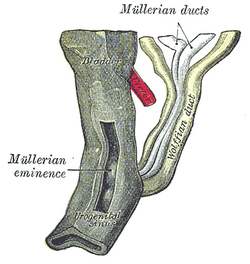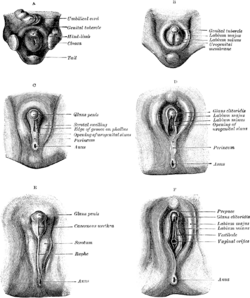Urogenital sinus
| Urogenital sinus | |
|---|---|
 Urogenital sinus of female humanembryoof eight and a half to nine weeks old. (Urogenital sinus labeled at bottom.) | |
 Stages in the development of the external sexual organs in the male and female. ( "Opening of urogenital sinus" labeled in diagram D.) | |
| Details | |
| Carnegie stage | 15 |
| Precursor | Cloaca |
| Gives rise to | Urethra,bladder,vagina,vulval vestibule,Bartholin's glands,Skene's glands,prostate,bulbourethral glands |
| Identifiers | |
| Latin | sinus urogenitalis definitivus |
| TE | sinus_by_E5.7.3.1.0.0.1 E5.7.3.1.0.0.1 |
| Anatomical terminology | |
Theurogenital sinusis a body part of a human or otherplacentalonly present in thedevelopment of the urinary and reproductive organs.It is the ventral part of the cloaca, formed after thecloacaseparates from theanal canalduring the fourth to seventh weeks of development.[1]
In males, the UG sinus is divided into three regions: upper, pelvic, and phallic. The upper part gives rise to theurinary bladderand the pelvic part gives rise to the prostatic and membranous parts of theurethra,[1]theprostateand thebulbourethral glands(Cowper's). The phallic portion gives rise to the spongy (bulbar) part of the urethra and theurethral glands(Littré's).
In females, the pelvic part of the UG sinus gives rise to thesinovaginal bulbs,structures that will eventually form the inferior two thirds of thevagina.This process begins when the lower tip of theparamesonephric ducts,the structures that will eventually form theuterusandvaginal fornices,come in contact with the UG sinus. Shortly afterwards, thesinovaginal bulbsform as two solidevaginationsof the UG sinus. Cells in these bulbs divide to form a solidvaginal plate,which extends and then canalizes (hollows) to form the inferior portion of the vagina.[2]The female urogenital sinus also gives rise to the urethra,vestibule,Skene's glandsandBartholin's glands.
Clinical significance[edit]
Aurogenital sinus anomalyis also a rarebirth defectinwomenwhere theurethraandvaginaboth open into a common channel.[3][4]
Apersistent cloacais a disorder where therectum,vagina,andurinary tractmeet and fuse, creating acloaca,a single common channel.[5]
Other animals[edit]
In many mammals (excluding primates),[6]the urogenital sinus refers to the sinus in which the openings to the female's urethra and vagina are found.[6][7][8][9]However, this term may also apply to some male mammals. The urogenital sinus of non-primates is homologous to thevulval vestibuleof primates.
Additional images[edit]
-
Enlarged view from the front of the leftWolffian bodybefore the establishment of the distinction of sex.
See also[edit]
References[edit]
- ^abSadler & Langman 2010,pp. 243–244.
- ^Sadler & Langman 2010,pp. 253.
- ^Callahan, Gerald N. (2009).Between XX and XY: intersexuality and the myth of two sexes.Chicago, Ill.: Chicago Review Press. p. 182.ISBN978-1-56976-289-9.OCLC436089205.
- ^"Urogenital Sinus".Children's Hospital of Orange County.2023-02-23.Retrieved2023-10-07.
- ^Jenkins D, Bitner-Glindzicz M, Thomasson L, et al. (2007), "Mutational analyses of UPIIIA, SHH, EFNB2 and HNF1β in persistent cloaca and associated kidney malformations",J Pediatr Urol,3(1): 2–9,doi:10.1016/j.jpurol.2006.03.002,PMC1864944,PMID17476318.
- ^abSchatten, Heide; Constantinescu, Gheorghe M. (2007-08-14).Comparative Reproductive Biology.John Wiley & Sons.ISBN978-0-8138-1554-1.
- ^Armati, Patricia J.; Dickman, Chris R.; Hume, Ian D. (2006-08-17).Marsupials.Cambridge University Press.ISBN978-1-139-45742-2.
- ^Grant, Tom (1995).The Platypus: A Unique Mammal.UNSW Press.ISBN978-0-86840-143-0.
- ^Tyndale-Biscoe, C. Hugh; Renfree, Marilyn (1987-01-30).Reproductive Physiology of Marsupials.Cambridge University Press.ISBN978-0-521-33792-2.
Sources[edit]
- Sadler, T. W.; Langman, Jan (2010).Langman's Medical Embryology.Philadelphia: Lippincott William & Wilkins.ISBN978-0-7817-9485-5.OCLC1194422650.
External links[edit]
- "Pediatric Conditions - Abnormalities - Vaginal Anomalies: Urogenital Sinus".UrologyHealth.org.2003-04-29. Archived fromthe originalon 2004-02-18.
- "Fetal Pig Dissection".Medicine LibreTexts.2020-10-15.Retrieved2023-10-08.
- "Development of the reproductive system".Am Boss.2022-03-30.
- "Differentiation of the urogenital sinus in males".embryology.ch.2007-09-27. Archived fromthe originalon 2018-02-15.

